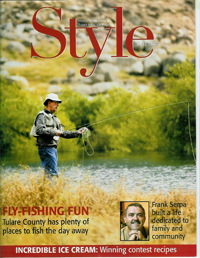"Home" - Style Magazine
By Gabriel Alexander

When the valley oak in Ken Puryear's yard fell over, he decided to replace it with palm trees found scattered throughout Tulare County. Four jubaea palms in front of his Visalia house in the Lakes came from a farm in Dinuba. The shaggy, multitrunked date palm worth thousands of dollars came from a man in Tulare who said, "Get that thing out of my yard."
And Canary palms were transplanted from rural areas near Badger Hill and Springville.
In February, landscaper Steve Cox's arrangement of the palms won the California Landscape Contractors Association's annual landscaping competition for "best entry for all residential categories."
"It says this is the best landscape in the state," says John Sassaman, communications manager for CLCA, and organization of state licensed landscapers.
Cox was shocked when he opened the letter about the award.
"I almost fell over," he said. "We compete will people in San Diego and the Bay Area where they have dot-com people building million-dollar mansions, so we are really honored."
The judges chose Cox's landscaping for its superior workmanship, Sassaman said.
"[Cox] came up with the stunning design, and he built the stunning design," he said.
Cox, of Plant Systems Inc., spent more than a year on the one-acre yard of Puryear and his wife Alicia Holland. Puryear told him he wanted it to look like the Mirage hotel in Las Vegas. But there was one problem: There wasn't one palm tree on the property - just a traditional lawn, redwoods and azaleas.
"At first we thought he was crazy," Dick Edminster said.
Edminster now owns a business, Pioneer Palms, with Puryear, a retired dentist.
"We thought he'd do a little over here and a little over there, but the place was tore up," he said.
Cox thought there was too much open space. The stamped-concrete driveway and the back lawn sloping down to the lake needed to be broken up, he said.
"I see a lot of areas that are just lawn," Cox said. "I'm a believer in usable space."
Cox put an island of palm trees in the driveway and curved stone terraces in the lawn. Throughout the yard, he interrupted the vista with sitting areas, different elevations, and islands of trees and plants.
"It brings the curiosity out in people if they can't see what's ahead," Cox said. "I want to draw people down a pathway."
Cox calls the palm-tree islands "bouquets of color and texture." The 70 to 80 varieties of palms and cycads range from towering canary palms to short, squat sago palms used as shrubbery. Colors range from the silvery blue fan of the Mexican blue palm to the bright-red fronds of the flamethrower palm. Every tree is labeled with its botanical and common name.
Judges were impressed by steps Cox took to protect "the stars of the landscape - the palms," Sassaman said.
Cox creates microenvironments using larger trees to protect the tropical varieties from the extreme heat and frost of the Valley. It's a microclimate that allows a king palm native to Australia to thrive underneath Canary and date palms.
"We have palm trees never planted in this area before because people thought they couldn't take the frost we get in the winter," Cox said. "Now people realize…, wow, we can grow them here."
Digital moisture sensors protect other trees, measuring the moisture in the ground.
"That's something you don't usually see on a residential project," Sassaman said. "It's the little attention to detail that makes sure the landscape will look good in 10 years opposed to dying off next year."
Sometimes the trees don't make it, Cox said. But that's a risk he is willing to take.
"A lot of people tend to use what's safe," Cox said. "For me, I would get bored if I had to use the same thing over and over."
View Tropical Paradise Portfolio
Back to Publications
 When the valley oak in Ken Puryear's yard fell over, he decided to replace it with palm trees found scattered throughout Tulare County. Four jubaea palms in front of his Visalia house in the Lakes came from a farm in Dinuba. The shaggy, multitrunked date palm worth thousands of dollars came from a man in Tulare who said, "Get that thing out of my yard."
When the valley oak in Ken Puryear's yard fell over, he decided to replace it with palm trees found scattered throughout Tulare County. Four jubaea palms in front of his Visalia house in the Lakes came from a farm in Dinuba. The shaggy, multitrunked date palm worth thousands of dollars came from a man in Tulare who said, "Get that thing out of my yard."